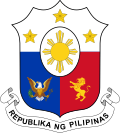History
Leyte was originally divided into four congressional districts from 1907 until 1931, when it was redistricted to five congressional districts by virtue of Act No. 3788. [1]
When seats for the upper house of the Philippine Legislature were elected from territory-based districts between 1916 and 1935, the province formed part of the ninth senatorial district which elected two out of the 24-member senate.
In the disruption caused by the Second World War, two delegates represented the province in the National Assembly of the Japanese-sponsored Second Philippine Republic: one was the provincial governor (an ex officio member), while the other was elected through a provincial assembly of KALIBAPI members during the Japanese occupation of the Philippines. Upon the restoration of the Philippine Commonwealth in 1945, the province retained its five pre-war representative districts.
Even after receiving their own city charters, Ormoc and Tacloban remained part of the representation of the Province of Leyte by virtue of Section 90 of Republic Act No. 179 (June 21, 1947), [2] and Section 91 of Republic Act No. 760 (June 20, 1952), [3] respectively.
Republic Act No. 2227, enacted on May 22, 1959, created the province of Southern Leyte from the southern municipalities of Leyte that constituted its third congressional district. [4] Per Section 5 of R.A. 2227, the incumbent representatives of all five districts of Leyte continued to serve for the remainder of 4th Congress. Starting in the 1961 elections, Leyte's remaining four districts were renumbered; the first, second, fourth and fifth districts were re-designated as the third, fourth, first and second districts, respectively.
Leyte was represented in the Interim Batasang Pambansa as part of Region VIII from 1978 to 1984. The province returned five representatives, elected at-large, to the Regular Batasang Pambansa in 1984.
Under the new Constitution which was proclaimed on February 11, 1987, the province was re-apportioned into five districts, [5] each of which elected its member to the restored House of Representatives starting that same year.
A plebiscite held on May 11, 1992, approved the establishment of Biliran (a sub-province of Leyte since 1959 [6] ) as a regular province, by virtue of Section 462 of Republic Act No. 7160 (Local Government Code of 1991). [7] Biliran continued to be represented as part of the third district of Leyte until it elected its own representative in the 1995 elections.
This page is based on this
Wikipedia article Text is available under the
CC BY-SA 4.0 license; additional terms may apply.
Images, videos and audio are available under their respective licenses.










